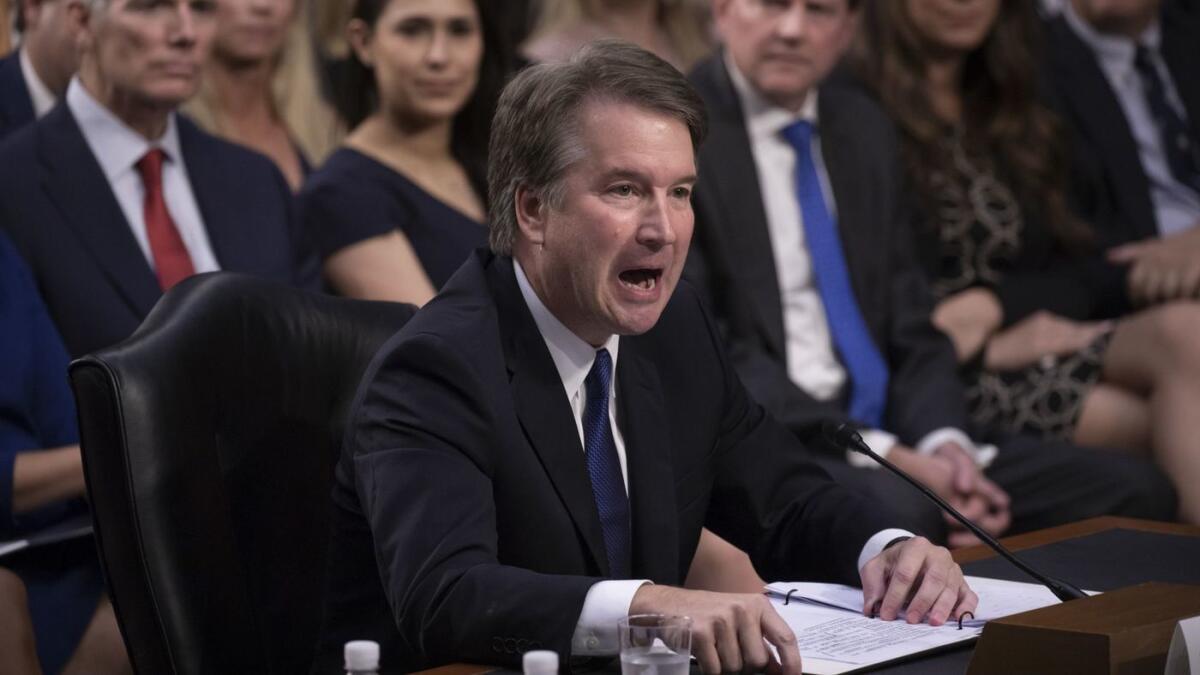Op-Ed: Connecting the dots on Brett Kavanaugh

- Share via
How should we judge Brett Kavanaugh’s denials about sexual misbehavior? We can run his assertions through our personal lie detectors, which we all possess based on our life experiences.
I find myself doubting Kavanaugh’s truthfulness about what happened to Christine Blasey Ford because I doubt his veracity about something that has gotten lost in the latest news: His testimony during the confirmation hearings when asked about the sexual improprieties of one of his mentors, retired Judge Alex Kozinski of the U.S. 9th Circuit Court of Appeals.
Last year, 15 women came forward to say Kozinski had harassed them physically or verbally over his four decades as a federal judge. Kozinski chose retirement rather than face an investigation into the allegations. Asked repeatedly by both Republican and Democrat senators about his knowledge of Kozinski’s bad acts, Kavanaugh said he never witnessed Kozinski “engaging in inappropriate behavior of a sexual nature.”
Along with his insistence that he never assaulted a younger girl when he was 17, these denials lead me to question Kavanaugh’s inclination to treat women as the full equals of men under the law.
Perhaps Kavanaugh can’t identify harassment, and possibly assault, or he doesn’t want to.
I first met Kozinski in summer 1992, when I began a clerkship with a different judge on the appeals court. Kavanaugh had completed his clerkship in the intimate Pasadena courthouse just as mine started.
My interactions with Kozinski were comparatively minimal and involved no inappropriate behavior on Kozinski’s part, but I did my best to spend as little time around him as possible. He had what I’ll call a creepiness factor — an older male authority-figure who expressed too much interest in the young women around him. It is hard for me to imagine that any of the judge’s clerks would not have known of reactions like mine, which were commonplace.
Kavanaugh was one of Kozinski’s star clerks. Kozinski helped him land a clerkship with Supreme Court Justice Anthony Kennedy. Within a decade, Kavanaugh was appointed a federal judge; then in 2006, President George W. Bush appointed him to the Court of Appeals for the D.C. Circuit, making him an equal of his mentor.
Kavanaugh couldn’t possibly have missed the furor over reporting about Kozinski’s questionable behavior in the Los Angeles Times in 2008. According to what Kozinski told The Times, he had maintained “for years” a website filled with sexually explicit images, and he had invited “friends” to view the images. Kozinski described what he uploaded to the site as “funny” and “interesting.” They included a video of a woman shaving her pubic area and a photo of a naked woman on all fours painted to look like a cow.
It simply doesn’t ring true to me that, as he asserted during the confirmation process, Kavanaugh would be in the dark about allegations of impropriety related to Kozinski. But in response to a question from Sen. Chris Coons (D-Del.), Kavanaugh wrote:
“To the best of my memory, no one ever raised concerns with me regarding inappropriate behavior of a sexual nature on the part of Judge Kozinski. Judge Kozinski worked in a small courthouse in Pasadena with then other judges, numerous law clerks, and court employees. Apparently, none of them knew of any misconduct, or they presumably would have reported it.”
As to Ford’s account, it does not strike me as nearly as far-fetched as Kavanaugh’s denials about Kozinski’s behavior.
Based on Kavanaugh’s senior-year yearbook, his all-boys Catholic school, Georgetown Prep, featured a culture of heavy drinking and misogyny. Photo captions brag about partying (“100 Kegs or Bust”) and make cringe-worthy jokes about violence against women (“Do these guys beat their wives?”). Georgetown Prep graduate Mark Judge, whom Ford implicates, along with Kavanaugh, in her assault, wrote a memoir of his debauched high school days, including drinking with a buddy he called “Bart O’Kavanaugh.”
Enter the Fray: First takes on the news of the minute from L.A. Times Opinion »
Had Ford gone to the police at the time with her story, authorities would have taken it seriously. She describes a house party where everyone was engaged in illegal, underage drinking, an aggravating factor under the law. Two older boys together pushed her into a bedroom, which could be seen as conspiracy to commit a crime. One of them clawed at her clothes and kept her from screaming with his hand over her mouth. She says she feared for her life.
Against Ford’s memory, we have seen a line-up of Kavanaugh’s former female clerks testifying to his outstanding mentorship. In addition, 65 women who “knew Brett well” in high school signed a letter attesting to his decency. On the personal side, stories about his devotion to his daughters, including coaching his older daughter’s basketball team, likewise affirm him as an enlightened father who seeks to give his girls equal opportunities.
But I can’t help connecting the dots between a boys-will-be-boys high school culture, socialization into the legal profession by a ribald mentor, and what appears to be a convenient, willful blindness to that mentor’s obvious missteps. Perhaps Kavanaugh can’t identify harassment, and possibly assault, or he doesn’t want to. Either way, I don’t trust him to protect women’s rights.
Laura E. Gómez is a law professor at UCLA and director of the Critical Race Studies Program. Her latest book is “Manifest Destinies: The Making of the Mexican American Race.”
Follow the Opinion section on Twitter @latimesopinionand Facebook
More to Read
A cure for the common opinion
Get thought-provoking perspectives with our weekly newsletter.
You may occasionally receive promotional content from the Los Angeles Times.









